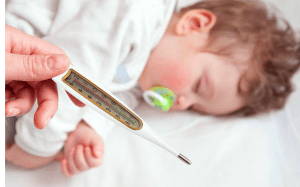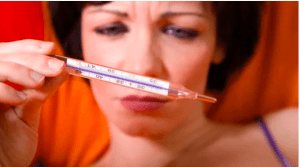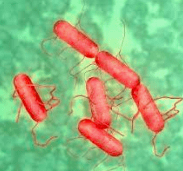Health
What Are The Symptoms And The Treatment Of Typhoid Fever?

Last Updated on November 15, 2022 by Nurse Vicky
What Are the Symptoms and the Treatment of Typhoid Fever?
Typhoid fever is a serious disease that can be fatal if not treated quickly and correctly. The symptoms of typhoid fever include fever, headache, body aches, nausea, and diarrhea.
Although typhoid fever is a highly treatable disease, if left untreated, it can lead to serious complications such as meningitis or even death.
In this blog, we will explore the symptoms of typhoid fever, the treatment options available, and how people get typhoid fever. Finally, we will provide a summary of the management and treatment of typhoid fever.
How is typhoid fever diagnosed?

Typhoid fever is a serious bacterial infection that can lead to serious health complications if not treated quickly.
Here are some key points that will help you get a proper diagnosis and treatment for typhoid fever: typhoid fever is diagnosed by using a blood test to measure the level of antibodies in your blood.
The treatment of typhoid fever will depend on the stage of the disease, which is described by symptoms. Early-stage typhoid fever may only require antibiotics and rest, while more serious cases may require hospitalization or even surgery to treat internal organs affected by the infection. If you suspect you may have typhoid fever, be sure to seek medical advice as soon as possible.
How is typhoid fever treated?

If you’re feeling feverish and have a rash, you might have typhoid fever. typhoid fever is a serious condition that requires immediate medical attention.
Symptoms of typhoid fever can range from mild to severe, and can even be life-threatening. If your symptoms are mild, antibiotics may not be necessary.
However, if symptoms are severe, antibiotics are the treatment of choice. Treatment for typhoid fever also includes drinking fluids, rest, and treatment of symptoms as they arise.
If left untreated, typhoid fever can lead to serious health complications, such as meningitis or even death.
So be sure to get checked out by a doctor if you experience any of the symptoms of typhoid fever.
Symptoms of typhoid fever

Typhoid fever is a serious infection caused by Typhoid bacteria. It is a highly contagious disease that can cause serious health complications, if not treated promptly.
Symptoms of typhoid fever include high fever, headache, body aches, diarrhea, and vomiting. If you experience any of these symptoms, it is important to seek medical attention as soon as possible.
If you are diagnosed with typhoid fever, antibiotics will be started to kill the Typhoid bacteria. If the patient is comatose or has seizures, they will be hospitalized for treatment.
With early diagnosis and treatment, most people recover without any long-term health effects. So, get vaccinated, stay healthy, and stay tuned for more typhoid fever updates!
Who does typhoid fever affect?

Typhoid fever is a serious illness that can affect anyone, but it mainly affects people who are poor and vulnerable.
The symptoms of typhoid fever can vary from person to person, but they all include a high fever, jaundice (yellowing of the skin and eyes), abdominal pain, and vomiting.
Typhoid fever is most commonly spread through contact with intestinal fluid from someone who has the disease.
There is no specific treatment for typhoid fever – it is just a matter of taking care of the symptoms until they go away on their own.
If you are worried that you may have contracted typhoid fever, see your doctor as soon as possible!
How do I take care of myself with typhoid fever?

Typhoid fever is a serious infection that can be deadly if left untreated. Here are some tips on how to take care of yourself while you’re sick:
1. Stay hydrated – drink plenty of fluids, especially water and electrolytes.
2. Eat clean food – avoid eating raw vegetables and fruits, as they can contain bacteria that can make typhoid fever worse.
3. Get plenty of rest – sleep as much as possible to help your body fight the disease effectively.
4. If you experience any symptoms of typhoid fever (high fever, severe headache, diarrhea, etc.), go to a hospital immediately for treatment!
How soon after treatment for typhoid fever will I feel better?

Typhoid fever symptoms can vary from person to person, so it is important that you see a doctor as soon as possible if you experience any of the following:
headache, body aches, fever, diarrhea, and vomiting. Most people will start feeling better within 4-6 days after treatment is complete.
However, some people may experience complications such as pneumonia or food poisoning which may prolong their recovery time.
How can I reduce my risk of typhoid fever?

Before 20 days, I was diagnosed with typhoid fever, but I only experienced mild symptoms. Typhoid was discovered in my blood after my doctor advised me to do a blood test due to severe fatigue, a headache, and gas.
It’s possible that it dates back two or three months. After that, I had to take some antibiotics for a total of 12 days, and I was finally done with them shortly before 5 or 6 days.
But starting yesterday, I’ve been experiencing a number of uncomfortable symptoms, including extreme weakness, the sensation that there is no blood in my body, sleepiness, occasional minor headaches, pain in both legs, and a slight increase in temperature throughout my body.
These symptoms are worse in the morning. My anxiety tends to increase in the morning, usually around nine in the morning or before breakfast.
I worry about what will happen to me and what is happening in my body. And after half an hour of having breakfast, it has begun to gradually diminish and is now acceptable. Is there another disease that still can’t be cured, or is it just typhoid?
Typhoid fever is a serious infection that can be deadly if not treated quickly. Here are some tips to help reduce your risk of contracting typhoid fever:
Always wash your hands thoroughly with soap and water, especially before you eat or drink. – Avoid close contact with people who are sick, as typhoid fever is contagious.
Drink plenty of fluids to stay hydrated and avoid becoming dehydrated from diarrhea. –
If you experience any of the symptoms of typhoid fever (high Fever, severe headache, poor appetite, dry mouth, and post-infectious diarrhea), see a doctor as soon as possible!
What can I expect if I have typhoid fever?

If you are infected with typhoid fever, there is a high risk of developing serious health complications. As such, it is important to take antibiotics as soon as you are diagnosed and drink plenty of fluids to rehydrate yourself.
In extreme cases, when symptoms such as confusion or difficulty breathing develop, seek medical attention immediately.
When can I go back to work or school after having typhoid fever?

Typhoid fever is a highly infectious and deadly illness, so it’s important to seek medical help as soon as you start feeling unwell.
If you are diagnosed with typhoid fever, make sure to rest and take antibiotics as prescribed by your doctor. However, in very rare cases it can be fatal if not treated promptly.
So please remember: always get vaccinated against typhoid fever and stay healthy overall!
Can you still be contagious with typhoid fever after you get better?
Typhoid fever is a serious bacterial infection that can be dangerous if not treated promptly. If you have recently contracted typhoid fever, it’s important to remember that you are still infectious and need to take antibiotics as soon as possible.
Make sure not to stay near people who are infected or spend time in crowded places – these environments may be contaminated with typhoid fever germs.
Finally, drink plenty of water and avoid over-the-counter medications as they might contain antibiotics which would only make your condition worse.
When should I see my healthcare provider about typhoid fever?

If you are experiencing any of the symptoms of typhoid fever, it is important to see a healthcare provider as soon as possible.
This includes fever, headache, abdominal pain, and vomiting. If left untreated, typhoid fever can lead to complications such as meningitis or sepsis (a serious bloodstream infection).
How did countries get rid of typhoid fever?

Typhoid fever is a deadly and potentially life-threatening disease that can be easily prevented by following some simple steps.
Here are four of them: 1. Stay away from food that may contain bacteria, such as seafood, raw fruits, vegetables, etc.
2. Drink plenty of fluids to avoid dehydration – this will help flush out the toxins created by typhoid fever symptoms.
3. Eat bland foods to prevent complications caused by food poisoning – high-sugar and high-fat meals increase your risk of getting sick with typhoid fever more than usual.
4 Keep a cool environment at all times – Typhoid fever symptoms are worsened in hot weather conditions!
What are the stages of typhoid fever?

Typhoid fever is a serious disease that can be life-threatening if not treated properly. Here are the five stages of typhoid fever as described by health experts:
1. The first stage is the mildest and most common one where the fever is around 38 degrees Celsius or 100 degrees Fahrenheit.
2. The second stage is when the fever rises to 39-40 degrees Celsius and there may be bouts of vomiting and abdominal pain.
3. The third stage is when typhoid becomes more severe with a risk of meningitis and sepsis. In case of serious infection, antibiotics are usually required to save the patient’s life.”
How long can a typhoid infection spread?

Typhoid fever is a bacterial infection that can be spread through close contact. The symptoms of typhoid fever can vary a lot, but they all involve high body temperatures and extreme body aches.
If you are infected with typhoid fever, the best way to prevent its spread is by taking antibiotics as soon as possible.
This will help clear the infection and lower your risk of getting it again in the future. If you do develop any of the following symptoms – fever, vomiting, diarrhea etcetera – see your doctor immediately for treatment!
What is the difference between typhoid and typhus?
 t
t
Typhoid fever and typhus are two diseases caused by different bacteria. Typhoid fever is a bacterial infection that causes fever, body aches, diarrhea, and vomiting.
Typhus is a more serious bacterial infection that can be fatal if not treated properly. The symptoms of typhoid fever are often more severe than those of typhus but both infections require treatment with antibiotics.
The best way to avoid getting either disease is to take preventive measures such as washing your hands regularly and avoiding food and drink from sick people or animals
Typhoid fever is a serious infection that can be deadly if not treated quickly. The symptoms of typhoid fever are headache, high fever, abdominal pain, diarrhea, and nausea/vomiting.
If left untreated, typhoid fever can lead to severe health complications or even death.
The best way to avoid typhoid fever is to know the symptoms and get treated as soon as you experience any of the symptoms.
Antibiotics are the first step in the treatment process and hydration and rest are also important.
If you experience typhoid fever, make sure to contact your healthcare provider so they can identify and treat the infection as quickly as possible.
Management and Treatment

Typhoid fever is a serious bacterial infection that can lead to serious health complications. If you or someone you know is infected, it’s important to know what the five symptoms of typhoid fever are and how to manage and treat the infection.
The first and most obvious symptom of typhoid fever is a high fever. Other symptoms of typhoid fever can include headache, abdominal pain, diarrhea, and vomiting.
To avoid getting typhoid fever, drink bottled or boiled water and eat safe foods such as fruits and vegetables.
If typhoid fever does occur, seek medical attention as soon as possible for treatment options that are available.
For example, antibiotics can help to stop the spread of the infection and improve the health of the patient.
How Do People Get Typhoid Fever?

Typhoid fever is a serious and potentially life-threatening illness caused by the bacterium Salmonella typhi.
It is most commonly spread through contact with contaminated water, food, or surfaces. The five symptoms of typhoid fever are sudden headache, high body temperature (39C or 101F), low blood pressure, diarrhea which may be bloody, and vomiting.
Treatment involves antibiotics to cure the infection and supportive care such as hydration and rest. If you think you might have typhoid fever, go to your doctor immediately for diagnosis and treatment!
Frequently Asked Questions
What are the treatment options for typhoid fever?
There are five main symptoms of typhoid fever, and each needs to be treated in a different way:
1. Vomiting: This symptom needs to be stopped as soon as possible with fluids and meds. The person should drink plenty of water, take antibiotics if they have bloody diarrhea, and take paracetamol or ibuprofen for fever.
2. Diarrhea: This symptom needs to be cleared up with antibiotics. People with typhoid fever may need 2–4 antibiotics doses per day.
3. Seizures: This can occur in severe cases and may require an injection of lidocaine or diazepam. 4. Shock: This occurs when typhoid fever bacteria enter the bloodstream and affects the heart or other org
ans. It can be life-threatening and requires intensive treatment in a hospital setting.
5. Death: typhoid fever is a serious condition and can lead to death in rare cases.
Are there any side effects to taking antibiotics for typhoid fever?
If you are taking antibiotics for typhoid fever, there may be some side effects. The most common of these are diarrhea, stomach pain, vomiting, etc.
If you experience any of these symptoms while taking antibiotics, it is advised to consult a health professional.
Can I get Typhoid Fever if I’ve been to a country in which it’s endemic (i.e., where it’s common)?
Yes, typhoid fever is potentially contagious and can be contracted by people who have been in close contact with an infected person.
The five symptoms of typhoid fever are high fever, headache, severe stomach pain, body aches, and fatigue. If you have typhoid fever, antibiotics will help to stop the spread of the disease and rest will help to reduce your symptoms.
Is it necessary to visit a doctor when I have typhoid fever?
Yes, it is necessary to visit a doctor when you have typhoid fever as they will prescribe antibiotics and refer you to a specialist.
By visiting a doctor, you can avoid becoming infected with the disease again, get proper treatment, and be on the lookout for any of the five symptoms of typhoid fever- high temperature; headache; loss of appetite; stomach pain or diarrhea; yellowing of the skin and eyes.
How can I treat typhoid fever if I am symptomatic?
Treating typhoid fever includes drinking plenty of fluids, taking antibiotics as prescribed by your doctor, and resting in a dark and quiet place to reduce energy expenditure.
In addition, you may need to drink ginger tea or eat licorice root (Glycyrrhiza glabra) to relieve pain, stop vomiting, and improve blood circulation.
Are there any other preventive measures that I should take when contracting typhoid fever?
While typhoid fever is not a life-threatening disease, taking preventive measures can help lower your risk of contracting it. The following are some tips to follow:
1. Drink plenty of fluids: It’s important to keep hydrated during typhoid fever as this will help to reduce the severity of symptoms.
2. Eat fruits and vegetables: Fruits and vegetables are high in vitamin C, which can help to fight off infections. 3. Wash your hands frequently: Hand washing is one of the most important steps you can take to prevent typhoid fever.
Make sure to also use soap and water to clean any surfaces that may have come into contact with contaminated food or water.
4. Stay away from people who are sick: Typhoid fever is spread through close contact with people who are infected, so staying away from people who are ill is one of the best ways to prevent infection.
5. contact a healthcare provider if you develop any symptoms of typhoid fever.
What are the five symptoms of typhoid fever?
Here are the five symptoms of typhoid fever as listed by the Centers for Disease Control and Prevention (CDC):
1. Sudden onset of headache, high fever, diarrhea, and abdominal pain
2. Weakness, chest pain, dry cough (especially at night), muscle aches or stiffness, rash on the trunk or extremities 3. antibiotics to clear up the infection and reduce fever
Conclusion
Typhoid fever is a serious infection that can affect anyone, regardless of age or immunity status. If you suspect that you have typhoid fever, seek medical attention as soon as possible.
The symptoms of typhoid fever can be quite serious, and if not treated promptly, can lead to complications such as fever, muscle pain, and rash.
With the right treatment and management, typhoid fever can be successfully treated and prevented from spreading.
Make sure to read through this blog to learn about the symptoms, treatment, and prevention of typhoid fever.
Health
Understanding the Risk Factors for Developing Preeclampsia

Understanding the Risk Factors for Developing Preeclampsia
Preeclampsia is a serious pregnancy complication characterized by high blood pressure and potential damage to organs such as the liver and kidneys.
It usually occurs after the 20th week of pregnancy and can have significant implications for both the mother and the baby.
Identifying the risk factors associated with preeclampsia is crucial for early intervention and management.
This article delves into the various risk factors, how they contribute to the development of preeclampsia and strategies for monitoring and prevention.
What Is Preeclampsia?
Preeclampsia is a condition that affects approximately 5-8% of pregnancies worldwide. It typically manifests with elevated blood pressure and proteinuria (excess protein in the urine).
If left untreated, it can lead to severe complications such as eclampsia, which involves seizures and can jeopardize both maternal and fetal health.
Risk Factors for Preeclampsia
Understanding the risk factors for preeclampsia can help in early diagnosis and management. Below are the primary risk factors associated with this condition:
1. Previous History of Preeclampsia
Women who have experienced preeclampsia in previous pregnancies are at a higher risk of developing the condition in subsequent pregnancies. The recurrence risk is approximately 20-30% if preeclampsia occurs in a previous pregnancy.
2. First Pregnancy
The risk of preeclampsia is higher in women who are pregnant for the first time. This is thought to be related to the body’s adjustment to the physiological changes associated with pregnancy.
3. Advanced Maternal Age
Women who are over the age of 35 are more likely to develop preeclampsia. The increased risk is associated with age-related changes in blood vessels and the body’s ability to manage pregnancy-related stress.
4. Multiple Gestations
Carrying more than one baby (e.g., twins or triplets) increases the risk of preeclampsia. The body’s increased demands and altered placental development contribute to this heightened risk.
5. Obesity
Obesity is a significant risk factor for preeclampsia. Excess body weight can lead to increased blood pressure and insulin resistance, both of which are associated with a higher likelihood of developing preeclampsia.
6. Chronic Hypertension
Women with pre-existing high blood pressure are at a greater risk of developing preeclampsia. Chronic hypertension can exacerbate the blood pressure problems associated with preeclampsia.
7. Diabetes
Both type 1 and type 2 diabetes are associated with an increased risk of preeclampsia. Diabetes can affect blood vessel function and increase the likelihood of high blood pressure during pregnancy.
8. Kidney Disease
Pre-existing kidney conditions can elevate the risk of preeclampsia. The kidneys play a crucial role in managing blood pressure and fluid balance, and any pre-existing conditions can compromise their function.
9. Autoimmune Disorders
Certain autoimmune disorders, such as lupus and rheumatoid arthritis, can increase the risk of developing preeclampsia. These conditions can affect the body’s immune response and vascular health.
10. Family History
A family history of preeclampsia can indicate a genetic predisposition to the condition. Women with a family history are at an increased risk compared to those without such a history.
11. Poor Nutrition
Inadequate nutrition, particularly a lack of essential vitamins and minerals such as calcium and magnesium, can contribute to the development of preeclampsia. Proper prenatal care and nutrition are crucial for minimizing risk.
12. Infections
Certain infections during pregnancy, such as urinary tract infections, can be associated with an increased risk of preeclampsia. Infections can exacerbate the inflammatory processes involved in preeclampsia.
13. High Stress Levels
Chronic stress and poor mental health can impact overall well-being and contribute to conditions like preeclampsia. Managing stress through healthy lifestyle choices and support systems is important.
Monitoring and Prevention Strategies
Early monitoring and preventive measures can help manage the risk factors associated with preeclampsia:
- Regular Prenatal Visits: Frequent check-ups with a healthcare provider can help monitor blood pressure and other indicators of preeclampsia.
- Healthy Lifestyle Choices: Maintaining a balanced diet, engaging in regular physical activity, and managing weight can reduce the risk.
- Medication: In some cases, medications such as aspirin may be recommended to lower the risk of preeclampsia, especially for women with a high risk.
- Stress Management: Techniques such as mindfulness, relaxation exercises, and counseling can help manage stress and support overall health.
- Education and Awareness: Understanding the symptoms and risk factors of preeclampsia can help in early detection and timely intervention.
Conclusion
Preeclampsia is a complex condition with multiple risk factors. By recognizing these factors and taking proactive steps, expectant mothers can work with their healthcare providers to manage their risk and promote a healthier pregnancy.
Regular prenatal care, lifestyle modifications, and stress management are key to minimizing the impact of preeclampsia and ensuring the best possible outcomes for both mother and baby.
FAQs
1. What are the early signs of preeclampsia?
Early signs of preeclampsia include high blood pressure, proteinuria, swelling of the hands and feet, sudden weight gain, and severe headaches. It’s important to report any unusual symptoms to your healthcare provider promptly.
2. Can preeclampsia be prevented?
While not all cases of preeclampsia can be prevented, maintaining a healthy lifestyle, attending regular prenatal visits, and following your healthcare provider’s recommendations can help reduce the risk.
3. How is preeclampsia diagnosed?
Preeclampsia is diagnosed through routine prenatal screenings that monitor blood pressure and urine protein levels. If preeclampsia is suspected, additional tests may be conducted to assess kidney function and other health indicators.
4. What are the treatment options for preeclampsia?
Treatment options for preeclampsia depend on the severity of the condition. They may include medications to manage blood pressure, bed rest, and in severe cases, early delivery of the baby to protect both the mother and child.
5. Can preeclampsia affect future pregnancies?
Having preeclampsia in one pregnancy can increase the risk of developing it in future pregnancies. However, many women go on to have healthy pregnancies by managing risk factors and following their healthcare provider’s advice.
References:
Health
Top 5 Immunity-Boosting Fruits to Include in Your Diet

Top 5 Immunity-Boosting Fruits to Include in Your Diet
In our quest for better health, the immune system often takes center stage. One of the simplest and most effective ways to support this vital system is through a nutritious diet.
Fruits, rich in essential vitamins, minerals, and antioxidants, can play a significant role in strengthening your immune system.
In this article, we’ll explore the best fruits for boosting immunity, backed by scientific research, and provide practical tips for incorporating them into your daily routine.
Why Immune Health Matters
The immune system is our body’s defense mechanism against harmful pathogens, including bacteria, viruses, and toxins.
A robust immune system can help fend off illnesses and infections, and a balanced diet is crucial for maintaining its optimal function.
Fruits, in particular, offer a wealth of nutrients that can enhance immune response, improve overall health, and even prevent chronic diseases.
1. Citrus Fruits: Vitamin C Powerhouses
Oranges
Oranges are synonymous with vitamin C, a crucial nutrient for immune health. Vitamin C supports the production and function of white blood cells, which are essential for fighting infections.
Just one medium-sized orange provides about 70 mg of vitamin C, meeting the daily recommended intake for most adults.
Grapefruits
Grapefruits, another excellent source of vitamin C, also contain antioxidants like lycopene, which have been linked to reduced inflammation and improved immune function.
Enjoying half a grapefruit a day can contribute significantly to your vitamin C needs.
Lemons
Lemons are versatile fruits that not only boost your vitamin C intake but also support detoxification.
Adding lemon juice to water or dishes can enhance your immune system while providing a refreshing flavor.
2. Berries: Antioxidant-Rich Superfoods
Blueberries
Blueberries are packed with antioxidants, particularly flavonoids, which help combat oxidative stress and inflammation.
These antioxidants can enhance immune function and protect against chronic diseases. A cup of fresh blueberries is a delicious way to boost your immunity.
Strawberries
Strawberries are another berry with a high vitamin C content, along with various antioxidants that contribute to overall health.
A handful of strawberries can provide a significant portion of your daily vitamin C requirement.
Raspberries
Raspberries are rich in vitamins C and E, as well as fiber and antioxidants.
These nutrients work together to support immune health and maintain digestive well-being.
Incorporate raspberries into smoothies or salads for a tasty immune boost.
4. Papaya
Papaya is an excellent source of vitamin C, vitamin A, and digestive enzymes such as papain. These nutrients contribute to a stronger immune system by supporting cellular repair and reducing inflammation.
5. Pomegranate
Pomegranates are rich in antioxidants and vitamin C, which help combat oxidative stress and boost immune function. The anti-inflammatory properties of pomegranates also support overall health and wellness.
Incorporating these fruits into your daily diet can provide essential nutrients that support immune health and help protect your body against illnesses.
Frequently Asked Questions
1. How does vitamin C boost the immune system?
Vitamin C enhances the production of white blood cells, which are crucial for combating infections and illnesses. It also acts as an antioxidant, protecting cells from damage caused by free radicals.
2. Can berries help reduce inflammation?
Yes, berries are rich in antioxidants and vitamins that help reduce inflammation and oxidative stress, which can support overall immune function.
3. What are the benefits of kiwi for immune health?
Kiwi provide a high amount of vitamin C, which supports the immune system by increasing white blood cell production. It also contains vitamin K and folate, which are essential for maintaining overall health.
4. How does papaya contribute to immune health?
Papaya is high in vitamin C and vitamin A, which help strengthen the immune system. Additionally, the enzyme papain in papaya aids in digestion and reduces inflammation.
5. What makes pomegranates beneficial for immunity?
Pomegranates are rich in antioxidants and vitamin C, which help fight oxidative stress and inflammation, thereby supporting the immune system and overall health.
References:
Healthline – Best Fruits for Boosting Immunity
Health
Effective Medications to Lower Cholesterol: A Comprehensive Guide

Effective Medications to Lower Cholesterol: A Comprehensive Guide
High cholesterol is a common health issue that can significantly increase the risk of heart disease, stroke, and other serious health conditions. Fortunately, various medications are available to help manage and lower cholesterol levels.
In this guide, we’ll explore the most effective medications for lowering cholesterol, their mechanisms of action, potential side effects, and other crucial information to help you make informed decisions about your health.
Understanding Cholesterol and Its Impact on Health
Cholesterol is a fatty substance found in your blood. Your body needs cholesterol to build healthy cells, but having high levels of cholesterol can increase your risk of heart disease.
Cholesterol travels through your bloodstream in two main types of lipoproteins:
low-density lipoprotein (LDL) and high-density lipoprotein (HDL).
- LDL Cholesterol: Often referred to as “bad” cholesterol, LDL can build up in the walls of your arteries, leading to atherosclerosis, which can restrict blood flow and increase the risk of heart attacks and strokes.
- HDL Cholesterol: Known as “good” cholesterol, HDL helps remove LDL cholesterol from your arteries, reducing the risk of cardiovascular problems.
Why Medication May Be Necessary
Even with a healthy diet and regular exercise, some individuals may still struggle to manage their cholesterol levels.
This is where cholesterol-lowering medications come into play. These medications work in various ways to help lower LDL cholesterol and, in some cases, raise HDL cholesterol.
Types of Cholesterol-Lowering Medications
1. Statins
Statins are the most commonly prescribed medications for lowering LDL cholesterol.
They work by blocking a substance your body needs to make cholesterol, thus reducing the amount of LDL cholesterol in your bloodstream.
- Examples: Atorvastatin (Lipitor), Simvastatin (Zocor), Rosuvastatin (Crestor)
- Mechanism of Action: Statins inhibit the enzyme HMG-CoA reductase, which is involved in cholesterol production in the liver.
- Common Side Effects: Muscle pain, digestive problems, increased liver enzymes
- Benefits: Statins are highly effective in reducing LDL cholesterol levels and have been shown to lower the risk of heart attacks and strokes.
2. Bile Acid Sequestrants
Bile acid sequestrants work by binding to bile acids in the intestine, preventing them from being reabsorbed. This process forces the liver to use cholesterol to produce more bile acids, thus lowering LDL cholesterol levels.
- Examples: Cholestyramine (Prevalite), Colestipol (Colestid), Colesevelam (Welchol)
- Mechanism of Action: These drugs bind bile acids in the intestines, reducing cholesterol absorption.
- Common Side Effects: Constipation, bloating, nausea
- Benefits: Effective at lowering LDL cholesterol and can be used in conjunction with statins for enhanced results.
3. Niacin
Niacin (also known as vitamin B3) helps lower LDL cholesterol and raise HDL cholesterol levels.
It works by decreasing the liver’s production of LDL cholesterol and increasing HDL cholesterol.
- Examples: Niacor, Niaspan
- Mechanism of Action: Niacin reduces the production of LDL cholesterol and increases HDL cholesterol.
- Common Side Effects: Flushing, itching, liver damage (with high doses)
- Benefits: Effective in raising HDL cholesterol and lowering LDL cholesterol.
4. Fibric Acids
Fabric acids, or fibrates, are primarily used to lower triglyceride levels and can also help increase HDL cholesterol levels.
They work by activating a protein that helps break down triglycerides in the blood.
- Examples: Fenofibrate (Tricor), Gemfibrozil (Lopid)
- Mechanism of Action: They activate peroxisome proliferator-activated receptors (PPARs), which help in the breakdown of triglycerides.
- Common Side Effects: Muscle pain, liver abnormalities, gastrointestinal issues
- Benefits: Particularly useful for individuals with high triglyceride levels.
5. PCSK9 Inhibitors
PCSK9 inhibitors are a newer class of cholesterol-lowering medications that help the liver remove LDL cholesterol from the bloodstream more effectively.
- Examples: Alirocumab (Praluent), Evolocumab (Repatha)
- Mechanism of Action: These drugs inhibit the PCSK9 protein, which normally reduces the liver’s ability to remove LDL cholesterol from the blood.
- Common Side Effects: Injection site reactions, flu-like symptoms
- Benefits: Very effective at lowering LDL cholesterol, especially in individuals who cannot tolerate statins.
6. Cholesterol Absorption Inhibitors
Cholesterol absorption inhibitors work by blocking the absorption of cholesterol from the diet, which reduces the amount of cholesterol that enters your bloodstream.
- Examples: Ezetimibe (Zetia)
- Mechanism of Action: They inhibit the absorption of cholesterol in the small intestine.
- Common Side Effects: Diarrhea, stomach pain, muscle pain
- Benefits: Can be used alone or in combination with statins to lower LDL cholesterol.
Choosing the Right Medication
The choice of medication depends on various factors, including your overall health, the specific cholesterol issue you have, and how well you tolerate certain medications.
Your healthcare provider will help you determine the most appropriate medication based on your individual needs and medical history.
Lifestyle Modifications to Complement Medication
While medications are effective in managing cholesterol levels, they work best when combined with lifestyle changes.
Consider incorporating the following into your routine:
- Healthy Diet: Focus on a diet rich in fruits, vegetables, whole grains, and lean proteins while avoiding saturated fats and trans fats.
- Regular Exercise: Engage in at least 150 minutes of moderate aerobic activity or 75 minutes of vigorous activity per week.
- Weight Management: Achieve and maintain a healthy weight to help control cholesterol levels.
- Avoid Smoking and Limit Alcohol: Both smoking and excessive alcohol intake can negatively impact cholesterol levels.
Monitoring and Follow-Up
Regular follow-up with your healthcare provider is crucial to monitor your cholesterol levels and assess the effectiveness of your medication. Your doctor may adjust your treatment plan based on your progress and any side effects you experience.
Final Thoughts
Managing cholesterol is a critical aspect of maintaining cardiovascular health.
With a variety of effective medications available, it’s possible to lower LDL cholesterol levels and reduce the risk of heart disease and other complications.
However, medication alone is not a cure-all; combining it with lifestyle changes is essential for optimal results.
Always consult your healthcare provider for personalized advice and treatment plans tailored to your specific needs.
Frequently Asked Questions (FAQs)
1. What is the primary goal of cholesterol-lowering medications?
Cholesterol-lowering medications primarily aim to reduce LDL cholesterol levels in the blood, thereby decreasing the risk of cardiovascular diseases such as heart attacks and strokes.
2. Are there any natural alternatives to cholesterol-lowering medications?
Yes, some natural alternatives include dietary changes (e.g., increased intake of soluble fiber and omega-3 fatty acids), regular exercise, and weight management. However, these should be used in conjunction with, not as a replacement for, prescribed medications.
3. How long does it take for cholesterol-lowering medications to show results?
The effects of cholesterol-lowering medications can usually be observed within a few weeks, but it may take several months to see significant changes in cholesterol levels and overall cardiovascular risk.
4. Can cholesterol-lowering medications cause side effects?
Yes, some common side effects include muscle pain, digestive issues, and liver enzyme changes. It’s important to report any side effects to your healthcare provider for proper management.
5. Can I stop taking my cholesterol medication if my levels improve?
It’s important to consult your healthcare provider before making any changes to your medication regimen. Discontinuing medication without medical advice can lead to a rebound in cholesterol levels and an increased risk of heart disease.
References
Cholesterol-lowering Medications
-

 Trending Stories1 year ago
Trending Stories1 year agoCDC: 1 in 4 Americans Still COVID-Free by End of 2022
-

 Health5 years ago
Health5 years agoMeghan Trainor Shares Motivational New Song ‘Blink’
-

 Health2 years ago
Health2 years agoHow Long Does Monkey Pox Last Before It Surfaces in the Body?
-

 Health2 years ago
Health2 years agoWhat Causes Swollen Body? Understanding Edema and its Triggers
-

 Health3 years ago
Health3 years agoNutrition and the Importance of a Fitness Program – 3 Things to Know
-

 Health3 months ago
Health3 months agoHow Do Pawpaw Seeds Support Cardiovascular Health?
-

 Health3 years ago
Health3 years ago5 Weird Reasons Why Pimples Disappear After Marriage
-

 Health2 years ago
Health2 years agoHealth Benefits Of Pawpaw Seed? 7 Things To Know





